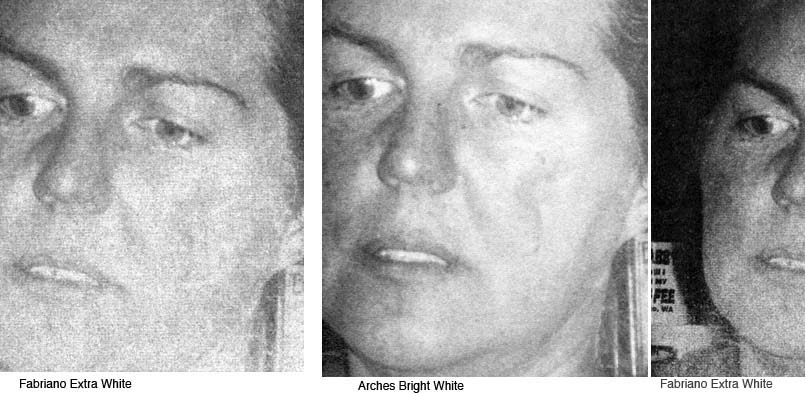
Beginning gum printers often think that if they don't get good results on the first try, they need to try a different paper. This is rarely if ever the case; in fact there are very few papers that gum can't be printed on, once the technique is mastered.
Essential characteristics of a gum printing paper: must react well to long soaks in water and have enough "tooth" or surface fiber to hold onto the gum. A wide variety of papers fit these requirements. Even papers that appear very smooth and even slick to our eyes and fingers, usually have plenty of tooth. Remember that it's molecules of gum that need something to hang onto, and even though gum molecules are huge compared to many chemical entities, they are still well below the threshold of the human eye to discern. So what may look and feel like a very smooth, toothless surface to us, may appear to a gum molecule like a terrain full of hills and valleys with lots of places to lodge oneself and be secure.
(That said, there are some surfaces that are so toothless they are difficult to print gum on, but these surfaces don't really qualify as "paper". Plastic surfaces, such as yupo or mylar, can be printed on by scuffing with sandpaper to provide some tooth, or by sizing with gesso mixed with gelatin; the gesso has a little grit in it that helps with adhesion of the gum. I've printed on yupo by preparing the surface with acrylic medium with some sand mixed in, which has the same effect).
Most watercolor papers and many printmaking papers work well for gum printing. Unsized Arches Aquarelle hot-press was my paper of choice for a decade, but I had to abandon it when it started coming from the factory with weird flaws in the internal sizing that showed in the print. Then I printed on Fabriano Uno, now unavailable, for a year or so but I disliked it for a number of reasons, mostly because unsized, it printed with attenuated DMax and contrast, and then for a while I printed on Magnani Pescia or Lana Aquarelle hot-press much of the time.
For the last few years I've been printing on Arches Bright White hot press as my standard paper of choice. It's crisp and smooth, and unlike most hot press watercolor papers, it keeps its smooth surface through multiple soakings. It's a little touchy for coating because the very crisp smooth surface can be difficult to coat smoothly, but its virtues outweigh its drawbacks, for me. It can't be printed unsized because of the nature of the internal sizing; I size it either with gelatin with a glyoxal hardener, or with gelatin mixed with gesso. I wouldn't recommend it as a paper to learn on; for a beginner paper you'd be better off with Fabriano Artistico Extra-White, which is more forgiving; I just don't happen to like its surface qualities.
If you do choose the Fabriano paper, I would recommend printing on the felt side (the side without a screen texture, the side where the watermark reads backward) because in my tests, I found that when printing on the wire side, the screen texture showed up in the gum print. Below are details showing the same gum emulsion (PBk11) printed on the wire side of Fabriano Artistico Extra-White and on the wire side of Arches Bright White (middle) plus a more pigmented mix of the same pigment (right) on the Fabriano paper. I printed a series of eight tests using different pigment concentrations; the only mix that didn't show the gridlines was the palest mix of all. These are one-coat prints; it's possible that with multiple printings the grid pattern is obscured somewhat, but I just prefer not printing on such obvious gridlines to start with. This drove me crazy for days because I kept thinking that I must have banding in my digital negative, but I couldn't see any banding in the negative, even with a strong loupe over a light table. Finally I printed the same image on the Arches bright white, which is a very smooth paper that shows any flaw in a negative, and when there no gridlines in this print, the light dawned: it wasn't the negative, but the paper.

Other papers I've printed gum on include: typing paper, card stock, Bristol plate surface board (doesn't work for multiple printings because it falls apart in the water on the second soaking, but if you just need one printing, it makes a beautiful sharp print), inkjet paper, Japanese papers of various sorts, mylar, drafting vellum, etc etc etc.
Daniel Smith used to sell sample packets containing small pieces of the papers they offer; my packets of paper samples, that I've had for years, are extremely well used. They've been soaked, gum-printed on, you name it. (In my packet of samples of Japanese paper, there is a little wad of what looks like paper mache, with a tag attached to it, written in my handwriting, "Hosho Professional DO NOT USE!) This was a wonderful way to try out a number of papers at little expense; I don't know if these sample packets are still available.
Copyright Katharine Thayer, all rights reserved